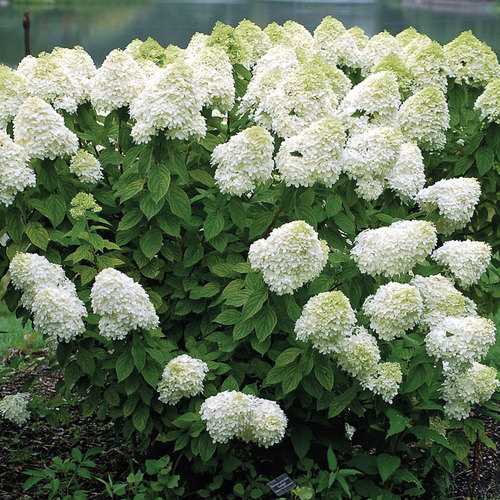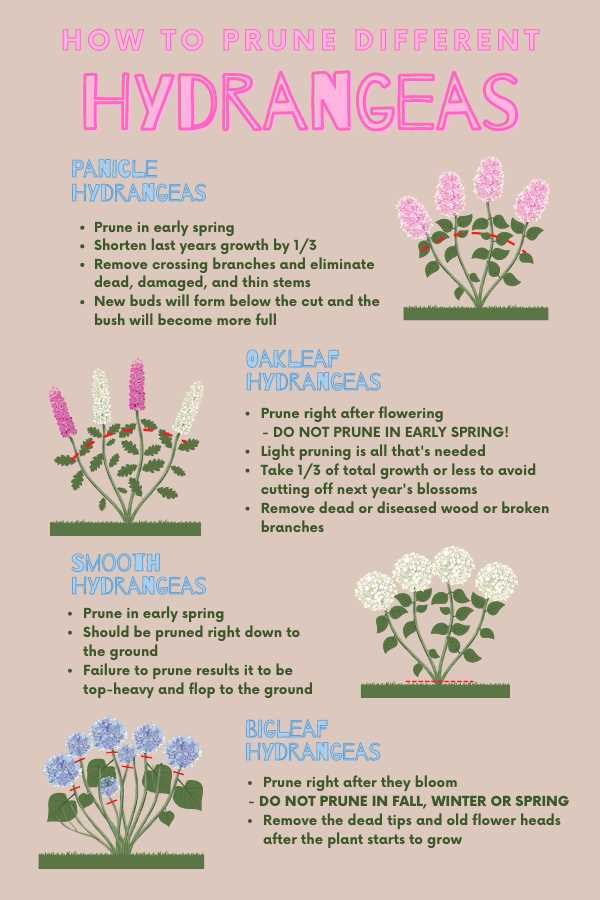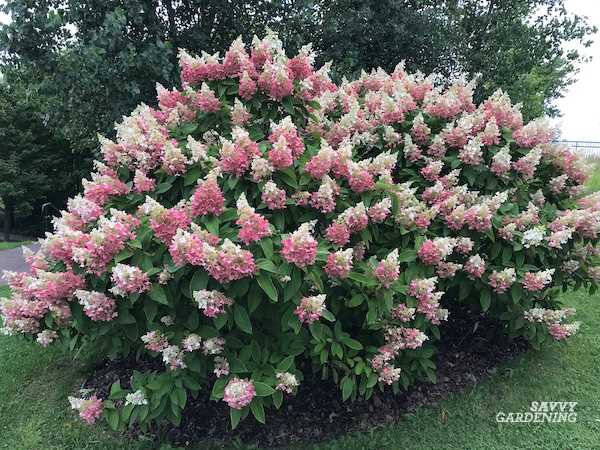- Importance of Pruning Panicle Hydrangea
- Benefits of Pruning Panicle Hydrangea
- When to Prune Panicle Hydrangea
- Pruning Techniques for Panicle Hydrangea
- Understanding Panicle Hydrangea
- Versatile and Hardy
- Growth Habit
- Flowering Time
- Pruning Panicle Hydrangeas
- Conclusion
- Pruning in Autumn: Pros and Cons
- Pros:
- Cons:
- Pruning in Spring: Pros and Cons
- Pros of Pruning in Spring
- Cons of Pruning in Spring
- Factors to Consider when Pruning Panicle Hydrangea
- 1. Time of Year
- 2. Growth Habit
- 3. Flowering Patterns
- 4. Desired Size and Shape
- 5. Health of the Plant
- 6. Personal Preference
- Best Practices for Pruning Panicle Hydrangea
- Tools and Techniques for Pruning Panicle Hydrangea
- Tools
- Techniques
- Questions and Answers:
- Can I prune panicle hydrangea in autumn?
- When is the best time to prune panicle hydrangea?
- Is it necessary to prune panicle hydrangea?
- What happens if I prune panicle hydrangea in autumn?
- Can I prune panicle hydrangea in early spring?
- How much should I prune panicle hydrangea?
- Videos: Try growing hydrangeas with flower stems | How to grow hydrangeas

The panicle hydrangea is a beautiful and popular ornamental shrub that produces cone-shaped flower clusters. Pruning is an important part of caring for panicle hydrangeas, as it helps maintain their shape, promote blooming, and remove dead or damaged branches. However, there is some debate about when is the best time to prune panicle hydrangeas: autumn or spring?
Traditionally, panicle hydrangeas were pruned in autumn, after the blooming period. This allowed the shrub to have a clean start in the spring, with fresh growth and abundant flowers. Autumn pruning also helps prevent disease and insect infestations, as the shrub gets rid of any potential hiding spots for pests.
However, some gardeners prefer to prune panicle hydrangeas in spring, before new growth begins. This allows them to assess the winter damage and remove any dead or broken branches. Spring pruning also ensures that the shrub blooms on new wood, resulting in larger and more vibrant flowers.
Importance of Pruning Panicle Hydrangea
Pruning is an essential task for maintaining the health and appearance of panicle hydrangeas. Regular pruning helps to promote proper growth, control size, and enhance the overall beauty of the plant. By removing dead or damaged wood and thinning out crowded branches, pruning encourages the growth of new stems and increases flower production.
Benefits of Pruning Panicle Hydrangea


Pruning panicle hydrangeas offers several benefits, including:
- Promoting Healthy Growth: Pruning helps to stimulate the growth of new shoots, ensuring a healthy and vigorous plant.
- Controlling Size: Panicle hydrangeas can grow quite large if left unpruned. By removing excess growth, pruning helps to maintain a manageable size for the plant.
- Enhancing Flower Production: Pruning panicle hydrangeas in late winter or early spring encourages the development of more vigorous and abundant flowers.
- Improving Air Circulation: By thinning out crowded branches, pruning allows for better air circulation, reducing the risk of diseases such as powdery mildew.
- Removing Dead Wood: Pruning also helps to eliminate dead or diseased wood, preventing further spread of diseases and improving the overall health of the plant.
When to Prune Panicle Hydrangea


The best time to prune panicle hydrangeas is in late winter or early spring, before new growth begins. This is because panicle hydrangeas bloom on new wood, meaning that they produce flowers on the current season’s growth. Pruning in late winter or early spring ensures that you won’t be removing any potential flower buds.
However, if you are looking to shape the plant or reduce its size, you can also do some light pruning in the fall, after the blooms have faded. Just be cautious not to remove too much, as it may affect the plant’s ability to produce flowers the following year.
Pruning Techniques for Panicle Hydrangea
When pruning panicle hydrangeas, follow these simple techniques:
- Remove Dead or Damaged Wood: Start by cutting out any dead or damaged wood back to healthy tissue. This helps to improve the plant’s overall health and appearance.
- Thin Out Crowded Branches: Remove any branches that are crossing or rubbing against each other. Thinning out the branches allows for better air circulation and prevents the spread of diseases.
- Shorten Long Stems: To control the size and shape of the plant, selectively prune back some of the longer stems. Cut them back to a pair of healthy buds or a desired length.
- Remove Faded Flowers: Once the flowers have faded, you can remove them to tidy up the appearance of the plant.
Remember to use clean, sharp pruning shears to make clean cuts, and always ensure that you are cutting just above a bud or leaf node to encourage new growth.
By following these pruning techniques, you can keep your panicle hydrangeas healthy, beautiful, and blooming year after year.
Understanding Panicle Hydrangea
Panicle hydrangea, also known as Hydrangea paniculata, is a popular flowering shrub in many gardens. It is native to Asia and is characterized by its cone-shaped flower clusters, which can range in color from white to pink and even red. Panicle hydrangeas are prized for their long-lasting blooms and their ability to thrive in a wide range of climates and soil conditions.
Versatile and Hardy
One of the key reasons why panicle hydrangeas are so popular is their versatility and hardiness. These shrubs can tolerate a wide range of soil types, from sandy to clay, and can even thrive in both acidic and alkaline soils. They are also relatively disease-resistant, making them a low-maintenance choice for gardeners.
Growth Habit
Panicle hydrangeas are deciduous shrubs that can grow up to 10 feet in height and spread up to 6 feet wide. They have a rounded shape and produce large, serrated leaves that add to their overall aesthetic appeal. These shrubs also have a fast growth rate, which means that they can quickly fill out a space in the garden.
Flowering Time
The flowering time of panicle hydrangeas is typically in the summer and early fall. The cone-shaped flower clusters start off as creamy white and gradually change color as they mature. As the flowers age, they can take on shades of pink, red, or a combination of both. The blooms of panicle hydrangeas can be quite showy and long-lasting, often remaining on the shrub well into the winter months.
Pruning Panicle Hydrangeas
When it comes to pruning panicle hydrangeas, timing is crucial. It is generally recommended to prune these shrubs in late winter or early spring, before new growth starts to emerge. This allows the plant to produce new branches and flowers for the upcoming season. Pruning at this time also allows you to shape the shrub and remove any dead or diseased wood.
It’s important to note that panicle hydrangeas bloom on new wood, meaning that the flower buds are formed on the current year’s growth. If you wait too long to prune, you risk removing the flower buds and missing out on a season of blooms.
Conclusion
Panicle hydrangeas are a versatile and hardy shrub that can bring beauty and color to any garden. Understanding their growth habit, flowering time, and proper pruning techniques is essential for keeping these plants healthy and ensuring a bountiful display of blooms each year.
Pruning in Autumn: Pros and Cons
Pruning panicle hydrangeas in autumn has both advantages and disadvantages. Here are the pros and cons of pruning in autumn:
Pros:
- Promotes new growth: Pruning in autumn stimulates new growth in the following spring. Cutting back the stems encourages the plant to produce more branches and flowers, resulting in a fuller and more vibrant hydrangea.
- Controls size: By pruning in autumn, you can control the size of your panicle hydrangea. This is especially beneficial if you have limited space in your garden or if the plant is getting too large and overpowering other nearby plants.
- Improves plant health: Removing dead or diseased branches in autumn helps prevent the spread of diseases and promotes overall plant health. It also allows more sunlight and airflow to reach the center of the plant, reducing the risk of fungal infections.
- Enhances shape and appearance: Pruning in autumn allows you to shape the plant and maintain its desired form. Removing overgrown or unruly branches helps create a neat and attractive appearance.
Cons:
- Reduced winter interest: Pruning in autumn removes the dried flower heads, which can provide winter interest to your garden. If you value the aesthetic appeal of the dried flowers, it may be best to wait until spring to prune.
- Delayed bloom: Pruning in autumn may delay the blooming of your panicle hydrangea in the following season. If you want your hydrangea to bloom as early as possible, it is recommended to prune in late winter or early spring.
- Increased risk of winter damage: Pruning in autumn exposes the fresh cuts to cold winter temperatures, which can increase the risk of damage. To minimize this risk, make sure to prune a few weeks before the first frost date in your area.
Overall, pruning in autumn can be beneficial for promoting new growth, controlling size, improving plant health, and enhancing the shape of your panicle hydrangea. However, it is important to consider the potential drawbacks such as reduced winter interest, delayed bloom, and increased risk of winter damage. Assess your specific needs and climate conditions before deciding when to prune your hydrangeas.
Pruning in Spring: Pros and Cons
Pruning panicle hydrangeas in spring presents both advantages and disadvantages. Consider the following pros and cons before deciding when to prune your plants:
Pros of Pruning in Spring
- Promotes better blooms: Pruning in spring allows you to remove any dead or old wood, which encourages new growth and leads to more abundant blooms.
- Enhances plant shape: By selectively removing branches and shaping the plant in spring, you can create a more well-balanced and aesthetically pleasing appearance.
- Simplifies winter protection: Pruning in spring helps to remove excess growth and reduce the overall size of the plant, making it easier to protect during winter months.
- Provides a fresh start: Spring pruning gives the hydrangea a chance to rejuvenate, removing any damaged or weak branches and allowing for healthy new growth.
Cons of Pruning in Spring
- Delay in blooming: Pruning in spring may delay the blooming of panicle hydrangeas since they typically set their flower buds in late summer and fall of the previous year. The more you prune, the later the blooms might appear.
- Increased risk of frost damage: Pruning in spring exposes the plant to the risk of late frosts, which can damage new growth and potentially affect flower production.
- Difficulty in distinguishing dead wood: In early spring, it can be challenging to determine which branches are dead and which ones are still alive. It is essential to exercise care and avoid removing too much healthy growth.
Ultimately, the decision of when to prune panicle hydrangeas comes down to personal preference and the specific needs of the plant. Considering the pros and cons can help you make an informed choice that will benefit the overall health and appearance of your hydrangeas.
Factors to Consider when Pruning Panicle Hydrangea


Pruning panicle hydrangea is an important task to maintain the health and appearance of the plant. However, there are several factors that need to be considered before pruning this type of hydrangea.
1. Time of Year
The timing of pruning is crucial for panicle hydrangeas. They can be pruned either in autumn or spring, depending on the desired results. Autumn pruning will remove the current year’s flowers but allow for new growth in the spring. Spring pruning, on the other hand, should be done before new growth emerges to retain the current year’s flowers.
2. Growth Habit
Understanding the growth habit of panicle hydrangea is essential for effective pruning. Panicle hydrangeas produce new growth from the base of the plant, as well as from the previous year’s wood. This means that they can tolerate more aggressive pruning compared to other hydrangea varieties.
3. Flowering Patterns
Knowing the flowering patterns of panicle hydrangea is crucial for making pruning decisions. Panicle hydrangeas produce flowers on new wood, meaning that pruning in autumn will not impact the upcoming year’s flowers significantly. However, if you want to retain the current year’s flowers, it is better to prune in early spring before new growth begins.
4. Desired Size and Shape
The desired size and shape of the panicle hydrangea also play a role in pruning decisions. If you want to maintain a compact and tidy appearance, regular pruning is necessary. Pruning can help control the size and shape of the plant by removing overgrown or crossing branches.
5. Health of the Plant
The overall health of the panicle hydrangea should also be considered before pruning. Pruning can help remove dead, damaged, or diseased wood, improving the overall health and vigor of the plant. Additionally, removing old wood can promote better air circulation and reduce the risk of fungal diseases.
6. Personal Preference
Ultimately, personal preference plays a significant role in pruning decisions for panicle hydrangea. Some gardeners prefer the natural growth habit and don’t prune heavily, while others prefer a more manicured appearance and prune more aggressively. Identifying your personal preference will guide your pruning practices.
It is important to remember that panicle hydrangeas are forgiving plants and can tolerate heavy pruning if necessary. However, it is always best to err on the side of caution and avoid removing too much of the plant at once, as it may impact the overall health and flowering of the hydrangea.
Best Practices for Pruning Panicle Hydrangea
Pruning panicle hydrangea is an important task that helps maintain the health and appearance of the plant. Here are some best practices to follow when pruning your panicle hydrangea:
- Prune in late winter or early spring: The best time to prune panicle hydrangeas is in late winter or early spring before new growth begins. This allows the plant to recover and produce new buds for the upcoming season.
- Remove dead or damaged branches: Start by removing any dead or damaged branches. These branches not only detract from the overall appearance of the plant but can also prevent new growth from occurring.
- Thin out overly dense areas: If your panicle hydrangea has become too crowded, thinning out some of the branches can help improve airflow and sunlight penetration. This also prevents the plant from becoming susceptible to diseases and pests.
- Prune for shape and size: You can prune panicle hydrangea to maintain a desired shape and size. Whether you prefer a compact bush or a more open and sprawling look, regular pruning can help achieve the desired form.
- Avoid over-pruning: While pruning is important, it is also crucial to avoid over-pruning panicle hydrangeas. These plants bloom on new wood, so excessive pruning can result in a reduced number of flowers. Stick to light to moderate pruning to ensure optimal flowering.
- Prune spent blooms in late summer: In late summer, you can deadhead the spent blooms of panicle hydrangea. This can help redirect energy towards the development of new buds for the following year.
Following these best practices for pruning panicle hydrangea will ensure a healthy and visually appealing plant. Remember to use sharp and clean pruning tools to minimize damage and always make cuts at a 45-degree angle just above a healthy bud or node.
Tools and Techniques for Pruning Panicle Hydrangea
Pruning is an essential part of maintaining the health and shape of your panicle hydrangea. By using the right tools and techniques, you can ensure that your shrub remains beautiful and blooms abundantly. Here are the tools and techniques you need to prune your panicle hydrangea effectively:
Tools


- Pruning shears: Invest in a pair of sharp pruning shears with a bypass blade. These shears will make clean cuts without crushing the stems.
- Hand pruners: A small pair of hand pruners is ideal for cutting back small branches and stems.
- Loppers: For thicker branches, use loppers with long handles for extra leverage.
- Pruning saw: If you have older, thicker branches that need to be removed, a pruning saw will make the job easier.
- Gloves: Protect your hands with sturdy gardening gloves that offer both comfort and protection.
- Disinfectant: Before moving on to the next cut, disinfect your tools with rubbing alcohol or a bleach solution to prevent the spread of diseases.
Techniques
When it comes to pruning panicle hydrangeas, there are a few key techniques to keep in mind:
- Remove dead or damaged wood: Start by inspecting your panicle hydrangea and removing any dead or damaged branches. This will allow the shrub to focus its energy on healthy growth.
- Thin out the center: Panicle hydrangeas can become dense and overcrowded over time. By selectively removing some of the older and weaker branches from the center, you’ll improve airflow and sunlight penetration.
- Shape the shrub: To maintain a neat and attractive shape, trim the top and sides of your panicle hydrangea. Aim for a slightly rounded or vase-like form, allowing the plant to have an open, airy structure.
- Prune after blooming: Panicle hydrangeas bloom on new wood, meaning they produce flower buds on fresh growth from the current season. It’s best to prune them in late winter or early spring before new growth begins. However, if necessary, you can also prune them in the fall, but you may sacrifice some flowering potential.
- Follow the 1/3 rule: When pruning your panicle hydrangea, avoid removing more than one-third of the plant’s total growth. This will prevent excessive stress and ensure the shrub remains healthy and vigorous.
By using the right tools and techniques, you can prune your panicle hydrangea effectively and enjoy a healthier, more vibrant plant. Remember to always observe proper pruning practices and follow the specific needs of your shrub for the best results.
Questions and Answers:
Can I prune panicle hydrangea in autumn?
Yes, you can prune panicle hydrangea in autumn. However, it is generally recommended to do major pruning in late winter or early spring.
When is the best time to prune panicle hydrangea?
The best time to prune panicle hydrangea is in late winter or early spring before new growth begins.
Is it necessary to prune panicle hydrangea?
Pruning panicle hydrangea is not necessary for its overall health and survival, but it can help maintain a desired size and shape and promote better flowering.
What happens if I prune panicle hydrangea in autumn?
If you prune panicle hydrangea in autumn, you risk removing potential flower buds for the following year’s blooms. It is generally advised to avoid major pruning in autumn.
Can I prune panicle hydrangea in early spring?
Yes, early spring is a good time to prune panicle hydrangea. Pruning in this time allows the plant to produce new growth and flower buds for the upcoming season.
How much should I prune panicle hydrangea?
The amount of pruning panicle hydrangea needs depends on the desired size and shape. It is generally recommended to remove about one third of the oldest stems each year to encourage new growth and maintain a healthy plant.







